
Application-to-Person (A2P) messaging has emerged as a powerful communication channel for businesses to engage with their customers. To leverage this channel effectively, businesses need to connect their systems and applications with A2P messaging services through APIs (Application Programming Interfaces).
When it comes to selecting the right API for A2P messaging, two popular options come into play: SOAP (Simple Object Access Protocol) and REST (Representational State Transfer). Each approach offers distinct features, benefits, and considerations, making it crucial for businesses to evaluate their specific needs and make an informed decision.
In this article, we will delve into the comparison of SOAP and REST APIs for A2P messaging, exploring their characteristics, technical aspects, use cases, and more. By understanding the differences between SOAP and REST, businesses can choose the most suitable API to unlock seamless communication with their customers.
SOAP API
SOAP (Simple Object Access Protocol) is a well-known messaging framework that heavily utilizes XML and schemas. It defines a strongly typed messaging model where each service operation is explicitly defined, including the XML structure of the request and response. This explicit definition in SOAP ensures a structured and standardized approach to communication.
Additionally, SOAP follows a set of industry-standard protocols and specifications. It uses WSDL (Web Services Description Language) to describe the structure and capabilities of the service.
The core principles of SOAP include:
- Protocol independence: SOAP allows communication between systems running on different platforms and using different protocols. It is not tied to any specific transport protocol and can work with HTTP, SMTP, FTP, or any other protocol.
- Extensibility: SOAP messages can contain additional elements and extensions to support custom functionality. It allows for flexibility in adding new features and capabilities without disrupting the existing infrastructure.
- Envelope-based messaging: SOAP messages are wrapped within an envelope that defines the structure and format of the message. This envelope includes a header section for additional information and a body section containing the actual data being transmitted.
- Message level security: Simple Object Access Protocol provides built-in support for security measures such as encryption, authentication, and digital signatures. This ensures the confidentiality, integrity, and authenticity of the transmitted messages.
- Complex data types: It supports complex data types, allowing the exchange of structured and hierarchical data. SOAP can handle diverse data formats and structures, making it suitable for scenarios that require complex data processing.
- Well-defined error handling: It defines a standardized approach for handling errors and exceptions, and includes error codes, fault messages, and fault handling mechanisms to ensure reliable communication and error recovery.
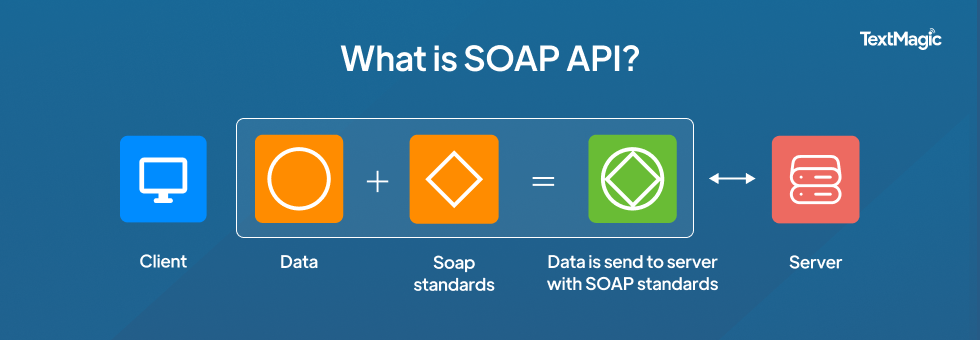
Benefits
- WSDL-enabled API description and usage: Developers will be able to use WSDL with SOAP. The Web Services Description Language, or WSDL, is frequently used to describe web service protocols and access techniques. It acts as a thorough reference for learning about API usage, and facilitates the building of APIs.
- Complex data support: It can handle complex data structures and supports rich data types, allowing for the exchange of structured and hierarchical data.
- Extensive tooling: It is suitable for complex enterprise integrations where advanced features like transaction management and service orchestration are required.
- Well-established ecosystem: SOAP has been widely used in enterprise systems and has a mature ecosystem with numerous tools, libraries, and frameworks available for development and integration.
Technical implementation
When it comes to implementing SOAP for A2P messaging, a systematic approach is required to ensure seamless integration and reliable communication. Here are the technical steps involved:
- Define the web service: Begin by defining the SOAP-based web service that will handle A2P messaging. Determine the operations, input parameters, and output responses that the service will support.
- Design the SOAP messages: Design the SOAP messages that will be exchanged between the client and server. Specify the structure and format of the SOAP envelope, including the header and body sections.
- Create the WSDL file: Generate the Web Services Description Language (WSDL) file that describes the SOAP-based service. The WSDL file provides a standardized way to define the web service interface, operations, and message formats.
- Implement the service: Develop the server-side implementation of the SOAP service using the programming language and framework of your choice. This involves writing the necessary code to handle incoming SOAP requests, process the data, and generate appropriate SOAP responses.
- Generate client proxy: Generate a client proxy or stub using the WSDL file. This allows client applications to easily communicate with the SOAP service by abstracting the underlying SOAP message handling.
- Invoke SOAP operations: Use the client proxy to invoke the SOAP operations exposed by the service. Construct the SOAP requests with the required input parameters and send them to the server. Receive and process the SOAP responses received from the server.
- Handle SOAP faults: Implement error handling and fault handling mechanisms to handle SOAP faults and exceptions that may occur during the SOAP communication. Handle error conditions gracefully and provide appropriate feedback to the client.
- Secure the communication: Implement security measures to ensure the confidentiality, integrity, and authenticity of the SOAP messages. Use encryption, digital signatures, and authentication mechanisms to protect the A2P messaging data.
- Test and debug: Thoroughly test and debug the SOAP implementation to ensure proper functionality and compatibility with other SOAP clients and servers. Perform comprehensive testing to validate the integration, message exchange, and error handling capabilities.
- Monitor and maintain: Continuously monitor the SOAP service to ensure its performance, availability, and reliability. Regularly update and maintain the SOAP implementation to address any security vulnerabilities or compatibility issues that may arise.
Sample message exchange:
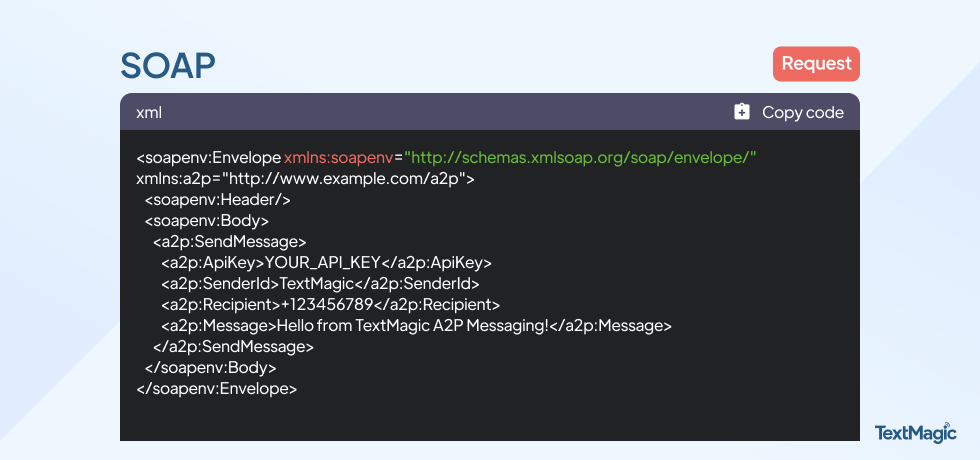
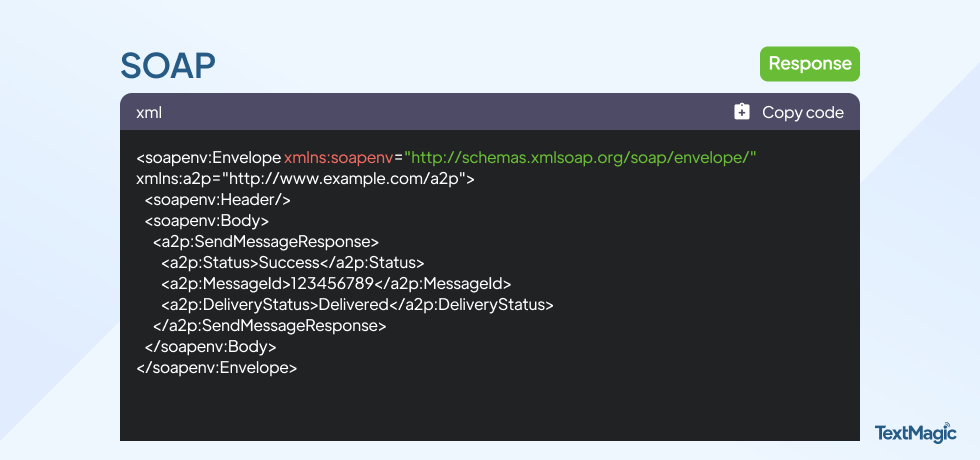
REST API
REST (REpresentational State Transfer) is a software architecture style developed for distributed systems, particularly the World Wide Web.
In an organizational structure that involves a sequence of links or state transitions that subsequently result in the next page, which represents the next state of the application for the user, REST architecture essentially follows specific requirements for how a well-constructed Web app works.
The core principles of REST include:
- Stateless communication: Each request from the client to the server contains all the necessary information, and the server does not store any client state between requests. This enables scalability and simplifies server-side implementation.
- Resource-oriented: REST treats everything as a resource that can be uniquely identified by a Uniform Resource Identifier (URI). Resources can represent entities, such as data objects, and are accessed and manipulated through standardized HTTP methods (GET, POST, PUT, DELETE).
- Uniform interface: REST promotes a uniform and consistent set of interactions between clients and servers. It utilizes standard HTTP methods, status codes, and headers for communication, making it easier for clients to understand and interact with APIs.
- Hypermedia as the Engine of Application State (HATEOAS): RESTful APIs can provide hyperlinks in responses, allowing clients to navigate and discover available resources and actions dynamically.
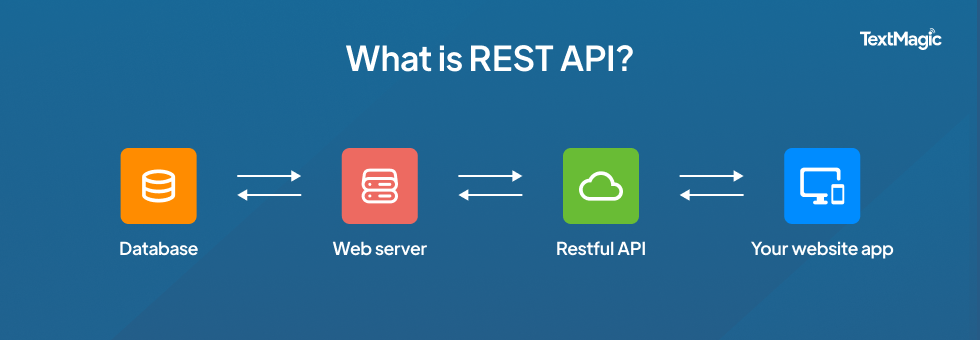
Benefits
- Scalability: The solution can be easily scaled by developers due to the split between the client and server.
- Flexibility and portability: As REST-style APIs depend on data from a single request to function effectively, switching servers is possible. Alterations to the information in the database can also be made at any moment.
- Independence: The protocol makes it simpler for innovations throughout a project to happen independently by separating client and server functions. REST APIs can be customized to the environment and working syntax, allowing developers the chance to test multiple environments concurrently as they are building.
- Standardization and norm establishment: While the SOAP architecture was likewise developed in 1998, it was created for XML and by the infrastructure titan Microsoft. The REST architecture was created concurrently with the HTTP protocol between 1996 and 1999, thereby becoming the norm for the following wave of APIs and standards.
- Integration: RESTful APIs facilitate seamless integration with various platforms and technologies. Its compatibility with standard web protocols allows for easy communication between different systems, enabling businesses to connect their A2P messaging capabilities with a wide range of applications, services, and devices.
Technical implementation
Implementing REST for A2P messaging involves several technical considerations. Here are the steps to implement it effectively:
- Define resources: Identify the key resources in your A2P messaging system, such as messages, recipients, campaigns, or delivery reports. Each resource should have a unique URI that represents its endpoint.
- HTTP methods: Map the appropriate HTTP methods (GET, POST, PUT, DELETE) to the corresponding operations on each resource. For example:
“POST” to send a new message
“GET” to retrieve message details
“PUT” to update a message
“DELETE” to remove a message
- Use of URIs: Design meaningful and intuitive URIs that reflect the hierarchy and relationships between resources. For instance, you may have URIs like /messages, /messages/{messageId}, or /recipients/{recipientId}.
- Data formats: Decide on the data format for exchanging information between the client and server. Most commonly used format is JSON (JavaScript Object Notation), but you need to make sure that the chosen format aligns with the requirements of your A2P messaging system.
- Request and response structure: Define the structure of request payloads and response messages. Specify the necessary parameters, headers, and body content for different API endpoints. Consider including authentication and authorization mechanisms to ensure secure access to the A2P messaging system.
- Error handling: Establish a consistent approach for handling errors and providing meaningful error messages. Define appropriate HTTP status codes (such as 200 for success, 400 for client errors, or 500 for server errors) to indicate the outcome of API requests.
- Documentation: Create comprehensive API documentation that describes the available endpoints, their functionalities, supported parameters, and example requests and responses. This documentation helps developers understand and integrate with your A2P messaging API effectively.
- Security: Implement security measures to protect sensitive data and prevent unauthorized access. Consider using techniques such as SSL/TLS encryption, authentication tokens, or API keys to secure the communication between clients and the A2P messaging system.
- Testing and monitoring: Conduct thorough testing to ensure the proper functioning of the REST API. Implement monitoring tools and techniques to track API usage, performance metrics, and potential issues.
Sample message exchange:
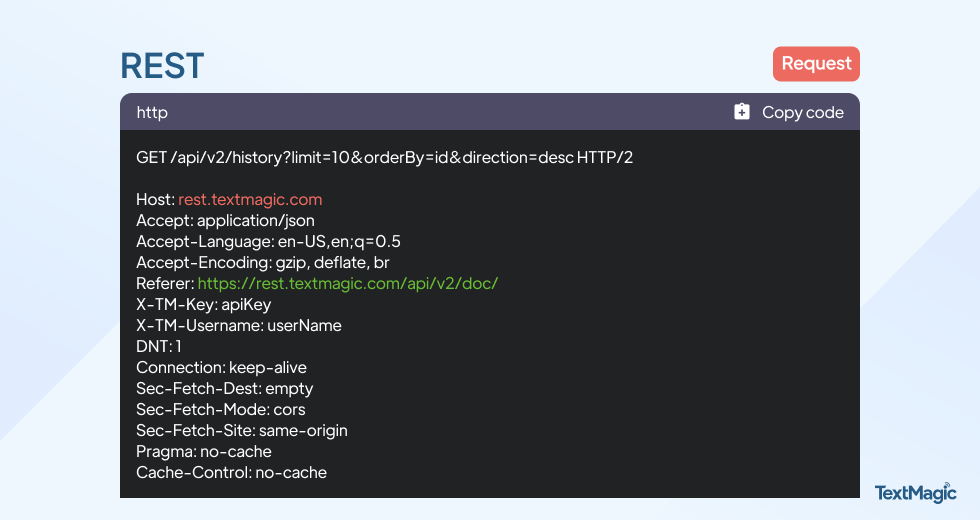
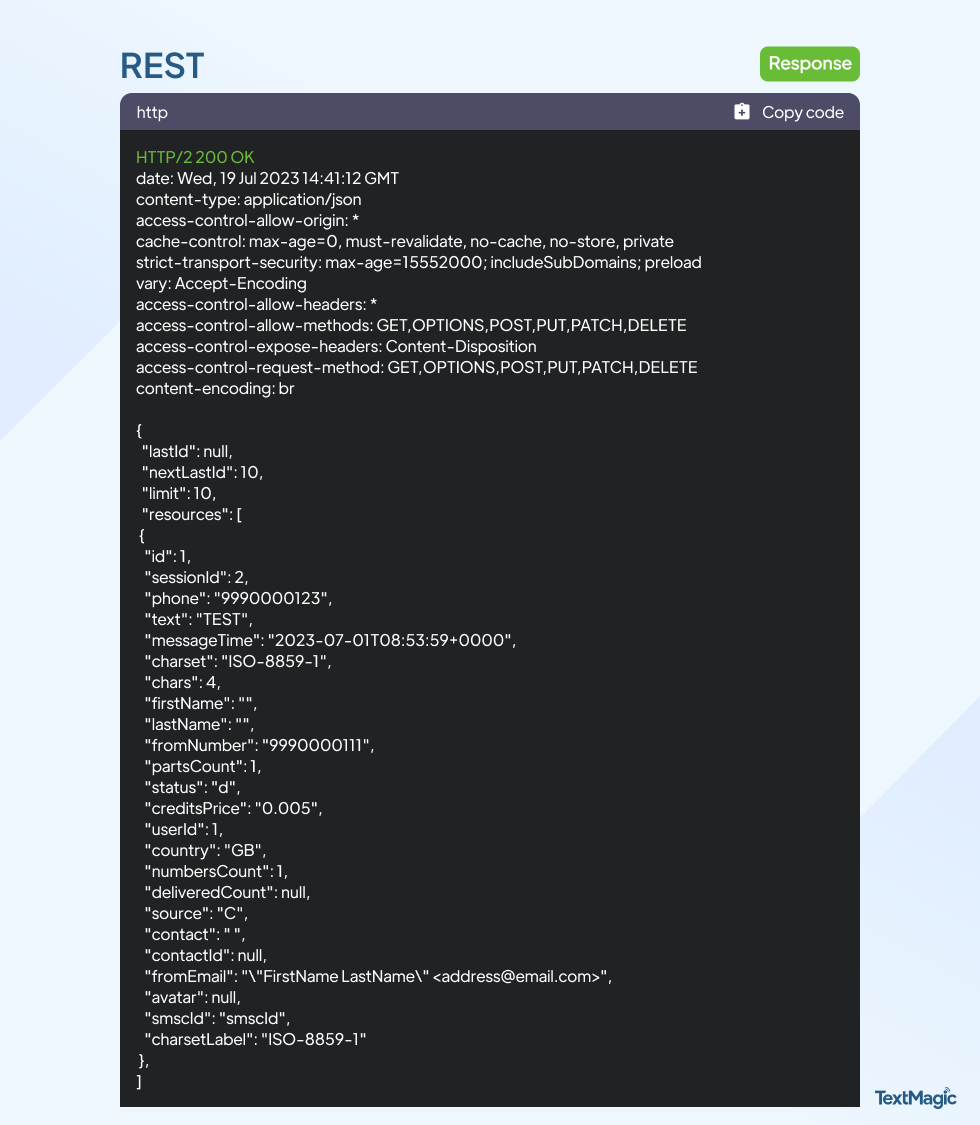
Comparing SOAP and REST APIs for A2P messaging
Choosing the right API architecture is crucial for seamless communication and efficient data exchange.
With its strong typing and extensive support for web service protocols, SOAP provides a structured and standardized approach for A2P messaging. It offers robust security features, reliable messaging capabilities, and comprehensive tooling support, making it suitable for enterprise-level integrations.
On the other hand, REST embraces a lightweight and flexible architectural style, allowing for easier adoption and integration with modern web technologies. REST APIs are known for their simplicity, scalability, and support for various data formats and protocols.
Ultimately, the choice between SOAP and REST depends on the specific requirements of the A2P messaging application, taking into consideration factors such as security needs, interoperability, and development simplicity.
We invite you to check out the infographic below for a clear and concise comparison between the two APIs:
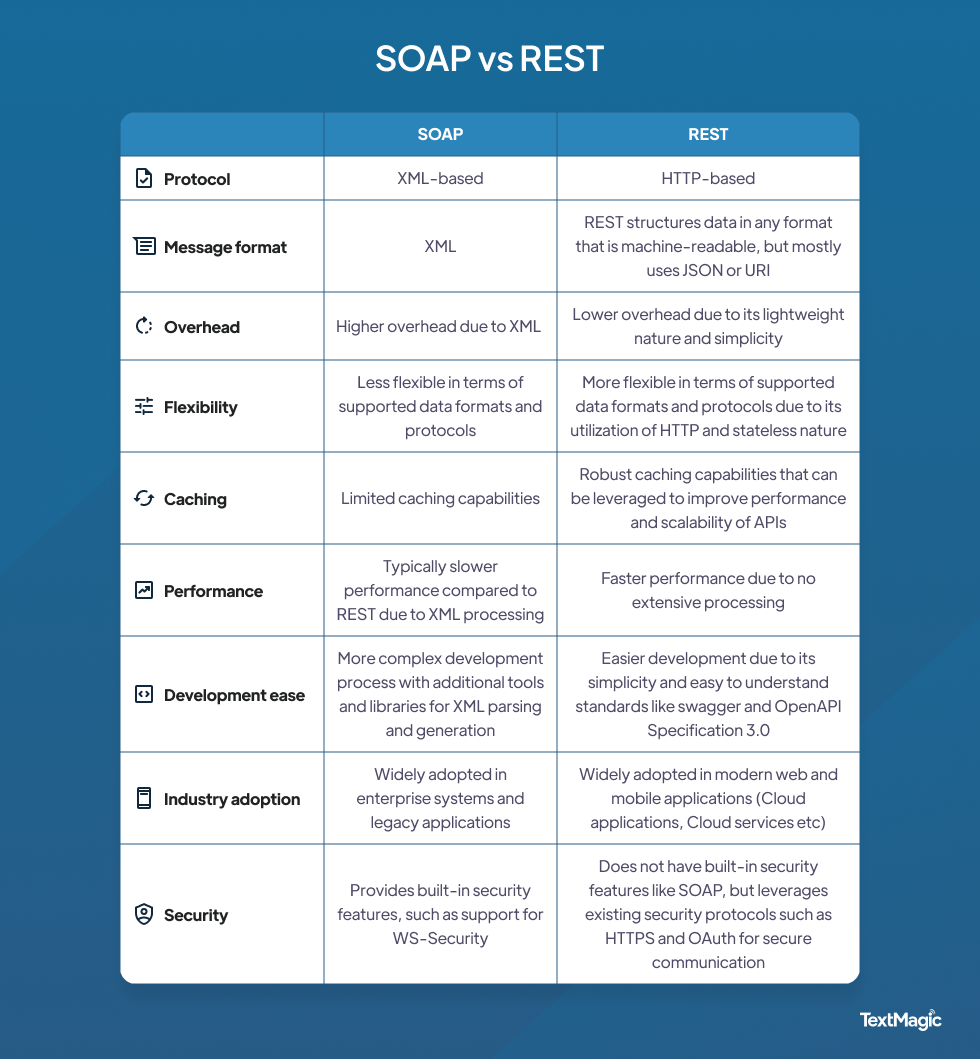
Choosing the right API for your A2P messaging needs
Selecting the right API is crucial for businesses seeking efficient and seamless communication with their customers. With an array of options available, understanding the key aspects to consider is essential for making an informed decision.
Factors to consider
When choosing the right API for your A2P messaging needs, several factors should be considered to ensure enhanced user experiences and successful customer interactions.:
- Functionality: Evaluate the API’s features and capabilities to ensure they align with your messaging requirements. Consider factors such as message sending, receiving, delivery status, personalization, and any specific functionality needed for your use case. SOAP APIs typically offer a richer set of predefined functions and data types, while REST APIs provide a more lightweight and flexible approach to accessing resources.
- Scalability: Determine if the API can handle the scale of your messaging needs. Consider factors like message throughput, concurrent connections, and the ability to handle high traffic volumes during peak times. SOAP APIs may have higher overhead and be more resource-intensive, which can impact scalability for high-volume messaging. REST APIs, on the other hand, are designed to be lightweight and scalable, making them suitable for handling large-scale messaging requirements.
- Reliability: Look for an API that offers reliable message delivery and minimal downtime. Consider the provider’s track record, service level agreements (SLAs), and customer reviews or testimonials.
- Complexity: SOAP APIs tend to have a higher learning curve and can be more complex to implement and maintain due to their extensive set of specifications and standards. REST APIs, with their simpler architectural style, are often easier to understand, implement, and troubleshoot.
- Security: Prioritize the security of your messaging communications. Ensure the API supports secure transmission protocols such as HTTPS and provides mechanisms for authentication, encryption, and access control to protect sensitive data. SOAP APIs often have built-in support for standardized security measures like WS-Security, making them suitable for applications with stringent security requirements. REST APIs can also provide security through HTTPS, but additional security measures may need to be implemented separately.
- Integration: Assess the API’s compatibility and ease of integration with your existing systems, platforms, or messaging infrastructure. Consider factors like programming language support, available SDKs or libraries, and documentation quality. SOAP APIs typically have extensive tooling and support for various programming languages, making them a good fit for enterprise systems and legacy applications. REST APIs, with their HTTP-based nature and widespread adoption, can seamlessly integrate with a wide range of platforms and technologies.
- Support and documentation: Assess the level of support and documentation provided by the API provider. Look for comprehensive documentation, developer resources, and access to technical support channels to assist with integration and troubleshooting.
- Cost: Evaluate the pricing structure of the API and its affordability for your messaging needs. Consider factors such as message volume pricing, additional fees for specific features or services, and any long-term commitment requirements. SOAP APIs may require additional resources and infrastructure due to their more complex nature, which can result in higher implementation and maintenance costs. Being lightweight and utilizing standard web technologies, REST APIs are often more cost-effective to develop, deploy, and maintain.
Use case examples
SOAP:
- Transactional notifications: SOAP-based A2P messaging APIs can efficiently handle transactional notifications, ensuring reliable delivery of order confirmations, shipping updates, and payment reminders.
- Enterprise legacy systems: SOAP is commonly used in enterprise systems and legacy applications where strict data formats and standardized protocols are required.
REST:
- Two-Factor Authentication (2FA): RESTful A2P messaging APIs are well-suited for implementing 2FA due to their simplicity and flexibility, allowing developers to easily integrate SMS verification codes into authentication systems.
- Marketing campaigns: RESTful A2P messaging APIs are commonly used for running marketing campaigns, providing a lightweight and scalable solution to send promotional offers and personalized marketing messages.
Conclusion
The choice between SOAP and REST APIs for A2P messaging depends on various factors and considerations.
When making a decision, it is important to consider the specific requirements of your A2P messaging application, including security needs, data complexity, scalability, and existing infrastructure. Assess the level of security, the need for standardization, and the available resources for implementation and maintenance. Additionally, consider the preferences and capabilities of your development team.
Ultimately, there is no one-size-fits-all answer, and the choice between SOAP and REST APIs should be based on a thorough evaluation of your specific use case and requirements. Consulting with experienced developers and considering the long-term scalability and maintenance aspects will help you make an informed decision that aligns with your business objectives and ensures successful A2P messaging integration.
Related articles
How to integrate Textmagic Tasks into your daily work routine
Teams can sometimes struggle to remain productive an...
What is CPaaS (Communications Platform-as-a-Service)?
Communications Platform as a Service (CPaaS) is cruc...
SOAP vs REST API for A2P messaging: Choosing the right approach
Application-to-Person (A2P) messaging has emerged as...
Best text marketing practices for cinemas
Text message marketing in the entertainment industry...
Scam text message examples and how to protect yourself from SMS phishing
Text message scams, also known as SMS scams or text ...




